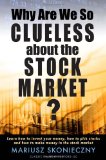Those of us who allocate capital for a living are probably familiar with fielding the following types of questions at social events, particularly during the holiday season:
“So, what hot stock can you recommend?”
“What do you think about [random stock that recently had a huge run]?”
“How did your investments perform last quarter compared to the market?”
“My portfolio is up 25% this month … How does your portfolio compare?”
For those who do not want to be perceived as rude and obnoxious, some type of response is usually required. The individual asking such questions is not doing so in order to appear uninformed and most likely has no exposure to the basics of investing. Such investors really need a primer on basic investment concepts and techniques. Even if they never invest any money on their own, basic knowledge is required to intelligently interact with hired professional managers.
A Beginner’s Guide to the Stock Market
Mariusz Skonieczny has written a beginner’s guide to the stock market in his book Why Are We So Clueless about the Stock Market? The book’s audience appears to be those who are new to business and investing concepts such as how businesses are capitalized and earn money from activities. Starting with a simple illustration of a Lemonade Stand’s balance sheet and income statement, Mr. Skonieczny walks the beginner through a number of scenarios regarding capital structures, return on equity, and the impact of competitors entering the market. Additionally, he provides an explanation of the power of compound interest which remains one of the least understood basic concepts of finance.
The Concept of Moats
The question of what qualities represent a “good business” is critical for those interested in handling their own investments. In illustrations that could be understood by any intelligent high school student, Mr. Skonieczny clearly shows the difference between businesses that create and destroy value. He also introduces the concept of opportunity cost and provides explanations of the key factors that sustain moats: Intangible assets, switching costs, network effects, and cost advantages.
Valuation
The chapter on valuation is quite basic but conveys enough information for a beginning investor to get started. The concept of compound growth is cleverly illustrated by comparing progress in net worth to an “elevator”. By avoiding compound interest equations and using illustrations, the discussion could be less intimidating to beginners. Through these illustrations, the book also explains the concept of discount rates.
Mr. Skonieczny also presents a simple valuation spreadsheet model which calculates intrinsic value based on a dividend discount model. While this model is clearly susceptible to the inability of most investors to forecast earnings or cash flow for distant periods in the future, it illustrates an important finance concept in a way that beginners can understand. One might worry that new investors could gain unwarranted confidence by coming up with seemingly precise forecasts of future earnings and plugging assumptions into a spreadsheet. However, attempts are made to explain such risks.
Capital Structure
The concept of capital structure and use of leverage is poorly understood by most investors. Again using simple illustrations, a chapter is provided that shows the impact of different mixes of equity and debt on a business. The fact that financial leverage is a double edged sword is obvious to experienced investors but not to beginners so more scenarios are provided which demonstrate how equity can be easily wiped out if a business carries too much debt and falls on hard times.
Case Study on Burlington Northern
Case studies using actual examples from earlier this year are presented in one of the later chapters. Interestingly, one of the case studies examines Burlington Northern which is expected to be acquired by Berkshire Hathaway early next year. The book was published prior to the announcement. The book also includes case studies on Moody’s, Thor Industries, and Wells Fargo. While fairly rudimentary, these examples show how the concepts discussed in the book can be applied to actual investment scenarios.
A Worthwhile Quick Read
This book is a worthwhile quick read for beginning investors. While it is definitely not a substitute for classics such as Ben Graham’s The Intelligent Investor, Mr. Skonieczny’s book can serve an important role by introducing new investors to basic concepts and serving as a starting point for further study.
The book could have been improved by providing an index as well as a list of suggested reading for those who wish to take the next step. In addition, the book’s title may be an obstacle for those who are thinking about gifts for friends, family, or clients who could use a basic primer on investing. After all, few of the folks asking you about last quarter’s performance or the next hot stock think that they are “clueless” about the stock market! It could be awkward giving this book as a gift for people who might be “clueless” but don’t recognize that fact. However, on balance, the substance of the book is very valuable and recommended for new investors.
Disclosure: Mr. Skonieczny provided The Rational Walk with a complimentary copy of his book to facilitate the book review.

